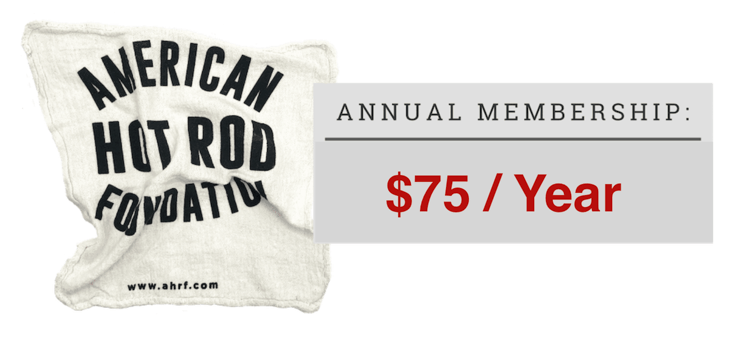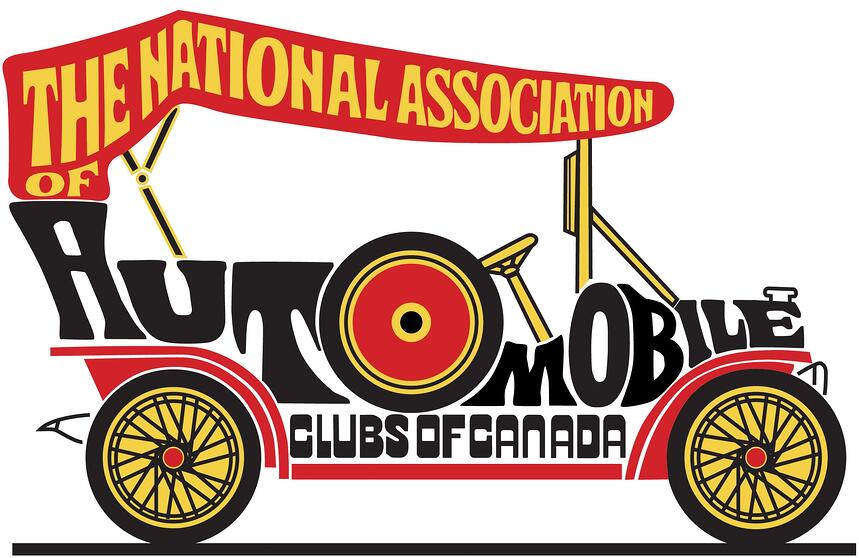It’s been a whacky last couple of weeks. In between scans we’ve been helping out our “old” friend (he’s 86 years old) Joe Henning move. He’s been in the same location for over three decades so needless to say has collected a lot of automotive memorabilia. We’re lucky enough to be able to scan some of his art and photos. An earlier batch of around 800 images have already been through our scanner and with the move, we’ve picked up hundreds more to share with you.
Let’s start with a couple of his illustrations. First up we’re looking at the 1960 version of the Larsen-Cummings front engined Modified Roadster that Joe Henning drew up for the boys at Petersen Publishing when he worked at Rod & Custom Magazine (JHC_1185). The car ran at Bonneville and the drags and every year received a new paint job by one Ed “Big Daddy” Roth. At Bonneville that year Fred drove the Blown Chrysler powered ’27 on Deuce rails to a new record of 212.585 mph. The scan was from an 8” x 10” print of his artwork.
Henning was/is the master at doing quick illustrations for use in the likes of R&C. This scan he’s dated from 1955 is from the original artwork that measured four inches high and seven inches wide (JHC_1186). A little watercolor, black ink and white paint on illustration board are all that was used.
Last week we mentioned the Bonneville had to be canceled. To give you a little salt fix how about this Cliff Wheeler shot that shows the Jugger’s Racing Team out of San Mateo, CA at Bonneville in 1957. The ’32 Ford ran in Class C Gas Roadster. A 283″ Chevy powered the car to a speed of 146.34 mph for first in class. Behind on the trailer is the De Armond & Markley Class B Roadster that was powered by a 259″ Dodge. It ran a slow 111.52 mph for second in class.
To solidify your fix here’s the program cover for the now non-happening 67th running of Bonneville Speedweek that was supposed to have taken place between August 8th to 14th, 2015 (JMC_5546). To make the pre-determined delivery date for the event, the printing was completed before iit was determined that the track surface was un-fixable. anyone for a basically worthless souvenir? We see the former George Poteet Class C Gas Roadster that has a new home and driver from Salt Lake City doing a dance step we call a twirl.
From day one we always thought that this car would have been perfect for some laps at Bonneville (JHC_1187). Back in 1968, Jack Adams had entered a radical new concept-car in the Indy 500 mile race. It was Turbine powered with Bob Herst as designated driver. It was called the Jack Adams-Wynn Storm but did not arrive at the track. Jack finally finished the car and brought it to the 1969 event as the Two Jacks, Inc entry. Al Miller was the driver and he put together four laps at an average speed 156.440 mph that was good enough to be second alternate for the race. William A. Moore did the great concept drawing of the car and Henning saved it all these years for us. Moore was also a regular contributor to the “Off the Sketchpad” feature in Rod & Custom Magazine.
Another print saved from extinction by Henning is this Tom Daniel proposed Indy Car illustration from back in 1967. We’re trying to figure out what team Tom did the drawing for as it doesn’t match up with the Wynn’s sponsored cars listed below. In ’67 Wynn’s hooked up with Mickey Thompson’s two-car team and both cars were a DNQ and didn’t look anything like the drawing. In ’68 Wynn’s put money on the Jack Adams car (the previous illustration) that didn’t even show up. Daniel was also well known for his “Off The Sketchpad” work in R&C and his wacky model car designs. We think with the enclosed canopy Bonneville would of been a perfect place to run the car.
Hot Rodder Frank McGurk is captured in his office back in 1935 at what looks like Oakland (CKC_1732). The number 24 car was called “The Red Head” but was officially known as the Utzman Special. This is the same Utzman that went by the name of Willie who ran at the lakes in the ’30s and would later build an OHC Studebaker engine for J. C. Agajanian that was a DNQ at Indy in ’52. McGurk started driving Track Roadsters in the early ’30s before graduating to Sprints and then Big cars and then to Chevy hot rod parts.
A publicity shot from the Monza (Italy) Race of Two Worlds shows Johnny Parsons in J. C. Agajanian’s Eddie Kuzma built Indy car. That guy Frank McGurk was the crew chief on car. Three separate races were held on 2.64 mile Autodromo Nazionale di Monza track June 29, 1957. Each was 63 laps or 166.32 miles long instead of one long one because tire was a problem because of the speeds reached. In the first race, Parson’s started 8th and finished 6th. In the second race, he started 6th and finished 3rd. In the final, he started 3rd and finish in 3rd. The average speed of the three races was 160.266 mph for the 498.96-mile grind. Compare that to Indy’s 135.6 race average and you can see that this was a fast one. The shot is from our friend “Sonny” Balcaen who originally built the Iacona Dragster, worked for Jim Hall and on the Reventlow Scarabs, made Camade Carroll Shelby’s Cobra parts business millions and ended up on the Board of Directors at the Petersen Museum. Not bad for a hot rodder.
While talking about Frank McGurk, yours truly did this sketch back in 1969 after I had gotten out of the Air Force (JMC_5547). Ed had just bought McGurk Engineering from Frank and was looking for ways to make the company more visible advertising wise. I didn’t get a job out of it but made a lifelong friend.
This McGurk decal was done for Isky by Joe Henning in yet another one of his zillions of illustration styles (JMC_1189). It wasn’t dated but roll cages put it sometime around 1970.
While on the decal kick, we got this Iskendarian Dealer Decal dated January 1964 from Ed’s brother Ben at lunch a couple of weeks ago (BIC_001). Thanks, Ben.
In one of his many past lives, Joe Henning was a contributor to the magazine “Old Car Illustrated” that was published in the late ’70s and early ’80s. He wrote and supplied pictures for many a story and our next shot hasn’t seen the light of day since then (JHC_1193). We see the field lined up before the start of the Elgin Road Race (South of Chicago) held on August 26, 1933. The circuit consisted of an 8.47-mile track on public roads made up of macadam, concrete and gravel racing surfaces. The entries consisted of 11 brand new Ford V8 powered roadsters, two Chevrolets, one Plymouth, and one Dodge. On the pole in this shot, we see the number 1 car of Shorty Cantlon in his ‘33 Ford that went on to finish in seventh place. Next to him in the number 2 Ford is Russell Snowberger who finished in sixth. In the second row is Dave Evans in the number 3 who finished 14th and Lou Moore in a Ford who finished in second. Starting way back in ninth place is Fred Frame who would go on to win the race. Back then the AAA would take a car off a dealer’s showroom floor and supervise the removal of fenders, windshield, mufflers, etc. Yep, they were really stock cars back in the day, or were they? Rumors persist that the dealers knew in advance and that the cars were tweaked before the AAA picked them.
We’re gonna fast forward fifty some years to another old Ford that went Road Racing. We see Frank “Duffy” Livingston’s “Eliminator” in a Pat Campea photo before it qualified for the Pomona Grand Prix held at the Pomona Fairgrounds on March 8, 1959 (PCC_068). The hot rod with a Ford-T body was powered by a 4.3 litre Vette engine that was hot enough to get him the 19th starting spot on the 52 car grid. Duffy soldiered through to finish in 11 spot overall and third in Class C behind Skip Hudson in a 4.9 Ferrari and Billy Krause in a 4.5 Maserati.
Duffy made his initial living building exhaust systems before he got in early on another So-Cal fad called carting. He started a little business in the city of Azusa called the Go-kart Manufacturing Company that really took off and made him a lot of bucks. This ad is from the back cover of the November 1959 issue of Rod & Custom Magazine (JMC_5550). Keeping it all in the family R&C Editor Lynn Wineland came up with the name Go Kart.
Following in the footsteps of other rod minded So-Cal gents like Sandy Belond, Bob Estes and Lou Senter to name a few, Duffy tried his hand at Big Time Racing. We see the number 46 Frank Kurtis built KK500G that was driven at Indy in 1960 by hot shoe Eddie Russo (BHC_047). The yellow car with red and blue markings was entered by C. O. Prather with the Duff’s sponsorship as the Go-Kart Special. Eddie qualified the car in 29th spot and then crashed out of the race in the southeast turn on the 84th lap for 26th spot. In the rear is the Demler Special that Paul Goldsmith finished third in.
As you may have guessed, around here pictures are pretty important. Finding anything that helps us unravel a centuries worth of shots is what we call Gold. In one of the boxes, we got from Henning was this to-die-for brochure printed by Roy Richter’s Bell Auto Parts right after WWII (JHC_1194). It consists of eight-page and lists hundreds of racing photos taken up and down the coast of California by venue. A great piece of research material we’d say. Our buddy Fred Chaparro said when he was a kid back in 1950 he would take multiple streetcar from his home in Boyle Heights all the way to Bell just to order prints. He would do the same thing the next week to pick up his order and then pick some more shots for the week after.
Back in 1949 photographer, Jerry Wright would send you ten 3 1/2″ x 5 1/2″ postcards for a buck, including the one cent postage. The cool thing is that the back would identify who was who in the shot. Here are four of 36 pristine cards we just found in another box from Henning (JHC_1195). In the upper left, we see what’s left of Walt Faulkner’s car after his first race at Gilmore in 1948. It was sent to Joe on August 4th, 1949. On the top right is that other famous Fresno driver Eli Vukovich. It was shot at Culver City and sent on September 12th. The bottom right shows Len Faas in his number 23 V8-60 powered Kurtis trying to get under Frank Armi in his number ’47 at Balboa (San Diego) sent on July 21. The bottom left shows a typical back of a card. It’s dated July 21. How many of you have stuff you picked up in ‘49? I bet not many. Thanks for being a great custodian Joe.
We’ve been hard at work cleaning up old newspaper clippings from the scrapbook we got from Mark Karolchik. This one’s from the Denver area dates back to 1938 and covers qualifying for that year’s Pikes Peak Hill Climb KCH_046). Great picture of Louis Unser cutting a corner.
Yesterday there was a car show held in “Beautiful Downtown Burbank” so naturally we had to go. Here are two shots. First up is a GTO? Not really, it’s just a Camaro with a new front end to kinda replicate a first-gen Pontiac Firebird (JMC_5548). While shooting the pix a guy walked up and asked is it really a Pontiac. We had to burst his bubble.
This, folks, is the innards of a hot-rodded 1948 MG TC. Brent Tarchero is the car’s longtime owner and builder. The engine is a 2.5 Liter Daimler V8 that came out of an fiberglass-bodied English sports-roadster that kinda looked like a Jag XK. They were built in the late ’50s. The engine is basically a scaled down Hemi and puts out gobs of ponies especially with that supercharger on top. Brent originally bought the engine to put into a Midget but we think it just fine where it rests.
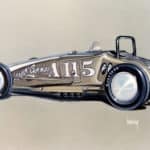
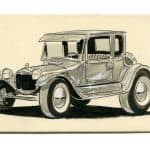
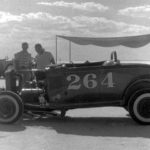
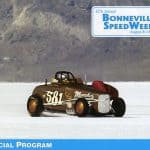
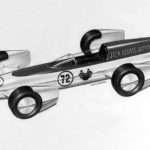
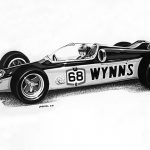
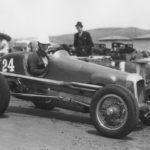
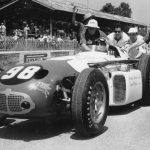
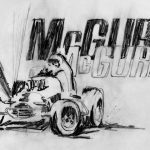
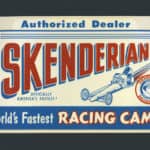
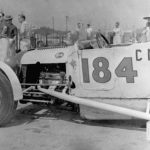
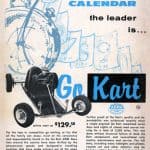
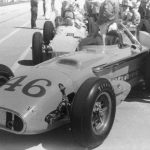
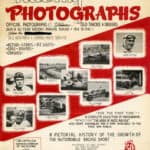
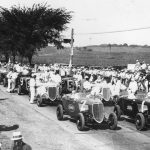
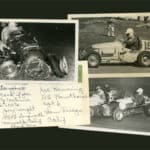
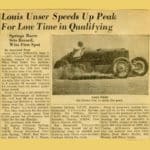
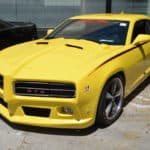
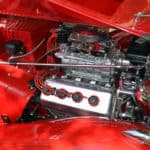
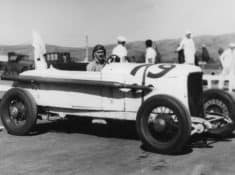 Anyone for Breakfast
Anyone for Breakfast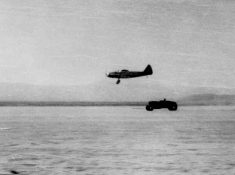 Dodging Young Drivers
Dodging Young Drivers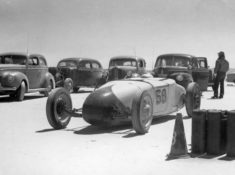 Pack Rats Rule
Pack Rats Rule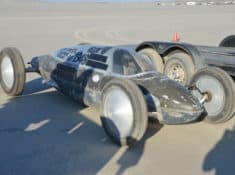 Variety is the Spice of Life
Variety is the Spice of Life